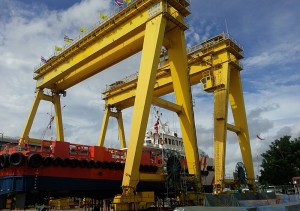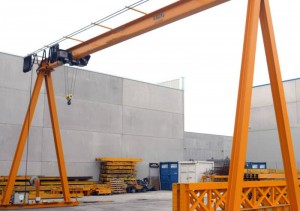
Diversified double-girder overhead crane capable of lifting various heavy objects
Components and Working Principle
Components and Working Principle of a Single Girder Overhead Crane:
- Single Girder: The main structure of a single girder overhead crane is a single beam that spans the working area. It is typically made of steel and provides support and a track for the crane’s components to move along.
- Hoist: The hoist is the lifting component of the crane. It consists of a motor, a drum or pulley system, and a hook or lifting attachment. The hoist is responsible for lifting and lowering loads.
- End Carriages: The end carriages are located on either side of the single girder and house the wheels or rollers that allow the crane to move along the runway. They are equipped with a motor and drive mechanism to provide horizontal movement.
- Bridge Drive System: The bridge drive system consists of a motor, gears, and wheels or rollers that enable the crane to travel along the length of the single girder. It provides the horizontal movement of the crane.
- Controls: The crane is controlled using a control panel or pendant control. These controls allow the operator to maneuver the crane, control the lifting and lowering of loads, and move the crane along the runway.
Working Principle:
The working principle of a single girder overhead crane involves the following steps:
- Power On: The crane is powered on, and the controls are activated.
- Lifting Operation: The operator uses the controls to activate the hoist motor, which starts the lifting mechanism. The hook or lifting attachment is lowered to the desired position, and the load is attached to it.
- Horizontal Movement: The operator activates the bridge drive system, which allows the crane to move horizontally along the single girder to the desired location above the working area.
- Vertical Movement: The operator uses the controls to activate the hoist motor, which lifts the load vertically. The load can be moved up or down as required.
- Horizontal Travel: Once the load has been lifted, the operator can use the controls to move the crane horizontally along the single girder to the desired position for placing the load.
- Lowering Operation: The operator activates the hoist motor in the lowering direction, gradually lowering the load to the desired position.
- Power Off: After the lifting and placing operations are completed, the crane is powered off, and the controls are deactivated.
It’s important to note that the specific components and working principles may vary depending on the design and manufacturer of the single girder overhead crane.
Features
- Space Efficiency: Single girder overhead cranes are known for their space-saving design. With a single beam spanning the working area, they require less overhead clearance compared to double girder cranes, making them suitable for facilities with limited headroom.
- Cost-Effective: Single girder cranes are generally more cost-effective than double girder cranes. Their simpler design and fewer components result in lower manufacturing and installation costs.
- Lighter Weight: Due to the use of a single beam, single girder cranes are lighter in weight compared to double girder cranes. This makes them easier to install, maintain, and operate.
- Versatility: Single girder overhead cranes can be customized to meet various lifting requirements. They are available in different configurations, lifting capacities, and spans, allowing them to be adapted to different work environments and load sizes.
- Flexibility: These cranes offer flexibility in terms of movement. They can travel along the length of the single girder, and the hoist can lift and lower loads as required. This makes them suitable for a wide range of applications, from light to medium duty lifting tasks.
- Easy Maintenance: Single girder cranes have a simpler structure, which makes maintenance and repairs relatively easier compared to double girder cranes. Access to components and inspection points is more convenient, reducing downtime during maintenance operations.







After-Sale Service and Maintenance
After purchasing a single girder overhead crane, it is important to consider after-sale service and maintenance to ensure its optimal performance, longevity, and safety. Here are some key aspects of after-sale service and maintenance:
- Manufacturer Support: Choose a reputable manufacturer or supplier that offers comprehensive after-sale service and support. They should have a dedicated service team to assist with installation, training, troubleshooting, and maintenance.
- Installation and Commissioning: The manufacturer or supplier should provide professional installation services to ensure the crane is properly set up and aligned. They should also conduct commissioning tests to verify the crane’s functionality and safety.
- Operator Training: Proper training for crane operators is crucial for safe and efficient operation. The manufacturer or supplier should offer training programs that cover crane operation, safety procedures, maintenance practices, and troubleshooting techniques.
















